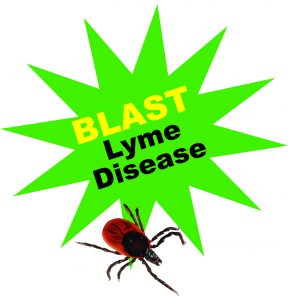DOVER – Lyme disease is the most common vector-borne disease in the United States with approximately 20,000 new cases reported each year. Delaware is among the top 10 states in the United States with the highest incidence rates. In 2018, the Division of Public Health (DPH) reported 520 confirmed and probable cases in the state.
As both the frequency of tick bites and the occurrence of Lyme disease increase as the weather warms up, DPH is ramping up its BLAST Lyme Disease awareness campaign and its outreach efforts. This year, these efforts are aimed at educating both the general public and medical providers about tick bite prevention, and how to best diagnose and treat Lyme disease. Additionally, Senate Concurrent Resolution 43, sponsored by State Senator Ernesto B. Lopez (R – SD 6) and Speaker of the House Pete Schwartzkopf (D – RD 14), recognizing May 19 – 25, 2019 as Lyme Disease Awareness Week in Delaware, passed both chambers on Thursday.
Lyme disease is a bacterial infection caused by the bites of blacklegged or deer ticks. Some, but not all, Lyme disease infections cause a red “bull’s eye” rash. Rashes can occur anywhere on the body and vary in size and shape. The rash can be warm to the touch and is usually not painful or itchy. Other symptoms are fever and/or chills, fatigue, muscle and joint aches, and headaches.
This week DPH epidemiologists are conducting interactive educational presentations at Delaware elementary and middle schools in order to increase awareness of tick-borne diseases, how to prevent tick bites, and how to safely remove ticks. Their efforts are an ongoing part of the BLAST campaign, which offer the presentations year-round to camps, schools and organizations. Any group or organization can request a presentation by calling 888-295-5156. BLAST is an acronym for remembering five simple steps you can take to protect yourself, family, and pets from Lyme disease:
• Bathe or shower within two hours of coming indoors.
• Look for ticks on your body and remove them.
• Apply repellent to your body and clothes.
• Spray your yard.
• Treat your pet.
Additionally, DPH is making poly-vinyl tick bite prevention trail signs available to all parks and municipalities statewide while supplies last. DPH will present nine of them to the Town of Milton on Wednesday, May 22 at 11:30 a.m. in Milton Memorial Park for posting at the entrances to the Town’s parks and walking trails. To reserve signs, call DPH at 302-744-4930. Also new this year are a series of short videos on tick bite prevention and removal (for humans and their pets) being added to DPH’s social media channels, and a short online survey for state employees to benchmark their awareness and knowledge of Lyme disease, and preventive and tick removal measures.
Most cases of Lyme disease can be cured with two to three weeks of antibiotics taken by mouth. However, a small percentage of patients with Lyme disease have symptoms like muscle and joint pains, arthritis, cognitive defects, sleep disturbance, and fatigue that last months or years after treatment with antibiotics, and can be challenging for the patient to live with. Also, Lyme disease can be difficult to diagnose, as not all patients with Lyme disease will develop the characteristic bull’s-eye rash, and tick exposures may often go undetected. Untreated infections can lead to severe joint pain and swelling (particularly the knees), loss of muscle tone on one or both sides of the face (called “Bell’s palsy”), dizziness, severe headaches and neck stiffness, and neurological problems.
To assist medical providers in diagnosing and treating Lyme disease, DPH has created educational flyers that will be distributed through state health care association partners. Also, since early recognition of Lyme disease decreases associated morbidity and promotes good health outcomes, DPH is providing links to two webinars that offer CEUs/CMEs on its website. A webinar produced by DPH and the Medical Society of Delaware describes the epidemiology (with particular emphasis on Delaware), early recognition, and prevention of Lyme disease. It is suitable for physicians, physician assistants, and all levels of nurses (i.e., advanced practice, RN, LPN) and can be found at: http://medicalthoughtleaders.com/MSD/LD/LD1.html through June 30, 2019. The Centers for Disease Control and Prevention also offers a free online course that teaches the proper identification and treatment of tick-borne diseases. Health care providers can visit https://www.cdc.gov/lyme/healthcare/index.html to learn more about the course and the credit hours available.
Other ongoing components of the BLAST Lyme Disease campaign includes print, radio, Facebook, and digital ads in English and Spanish, which began running in late April. DPH’s Lyme webpage at lyme.de/gov features detailed tick removal instructions and a printable poster of common symptoms, and a “Kids Korner” filled with engaging activities.
A person who is deaf, hard-of-hearing, deaf-blind or speech-disabled can call the DPH phone number above by using TTY services. Dial 7-1-1 or 800-232-5460 to type your conversation to a relay operator, who reads your conversation to a hearing person at DPH. The relay operator types the hearing person’s spoken words back to the TTY user. To learn more about TTY availability in Delaware, visit http://delawarerelay.com.
The Delaware Department of Health and Social Services is committed to improving the quality of the lives of Delaware’s citizens by promoting health and well-being, fostering self-sufficiency, and protecting vulnerable populations. DPH, a division of DHSS, urges Delawareans to make healthier choices with the 5-2-1 Almost None campaign: eat 5 or more fruits and vegetables each day, have no more than 2 hours of recreational screen time each day (includes TV, computer, gaming), get 1 or more hours of physical activity each day, and drink almost no sugary beverages.
